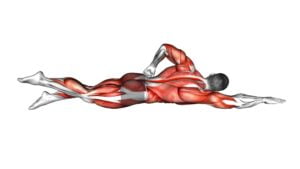Swimming Side Steps (female) – Video Exercise Guide & Tips

Are you looking for a fun and effective way to tone your body? Look no further than swimming side steps! This exercise targets your legs, glutes, and core, giving you a full-body workout in the water.
Watch This Exercise Video
In this video exercise guide, you'll learn the proper form and technique, as well as warm-up exercises to prepare your body. With tips for progression and safety precautions, you'll be able to increase the difficulty and stay safe while getting fit.
Let's dive in!
Key Takeaways
- Swimming side steps improve cardiovascular fitness.
- Swimming side steps tone lower body muscles.
- Swimming side steps enhance balance and stability.
- Swimming side steps are a low impact exercise and are ideal for individuals with joint or muscle pain.
Benefits of Swimming Side Steps
Swimming side steps offer numerous benefits for improving your overall cardiovascular fitness and toning your lower body. By incorporating these exercises into your workout routine, you can experience improved balance and a more effective cardiovascular workout.
Swimming side steps are a great way to challenge your body and increase your heart rate. As you move laterally in the water, your muscles are engaged in a dynamic and continuous movement. This constant motion not only strengthens your lower body muscles, but also provides an excellent cardiovascular workout.
Additionally, swimming side steps require coordination and balance, which can help improve your overall stability. As you perform these exercises, you're activating the muscles in your legs, glutes, and core, which are crucial for maintaining balance both in and out of the water.
Moreover, swimming side steps are low impact, making them an ideal exercise for individuals with joint or muscle pain. The water provides resistance, allowing you to work your muscles without putting excessive strain on your joints.
Proper Form and Technique
To perform swimming side steps with proper form and technique, it's important to focus on core engagement and arm and leg coordination.
Engaging your core muscles helps maintain stability and balance in the water, allowing for efficient movement.
Coordinating your arms and legs helps propel you forward and maintain a smooth and rhythmic motion.
Core Engagement During Swimming
Ensure optimal core engagement during your swim by focusing on proper form and technique.
Core stability plays a crucial role in swimming, as it helps you maintain balance and control in the water. To engage your core effectively, focus on maintaining a straight and aligned body position. This means keeping your head in line with your spine, your hips level, and your legs extending behind you.
Additionally, proper breathing techniques are essential for core engagement. Coordinate your breathing with your strokes, inhaling through your mouth or nose when your face is out of the water, and exhaling through your mouth or nose when your face is submerged.
Arm and Leg Coordination
Maintain optimal core engagement by coordinating your arms and legs with proper form and technique. Improving coordination between your arms and legs is essential for efficient swimming and maximizing your performance in the water. One common mistake isn't synchronizing your arm and leg movements, which can lead to a decrease in speed and efficiency.
To ensure proper coordination, focus on timing your arm strokes with your leg kicks. As your arm extends forward, initiate your leg kick to provide propulsion. Similarly, as your arm pulls back, kick your legs to generate power. By synchronizing your arm and leg movements, you'll improve your overall swimming technique and efficiency in the water.
Now, let's move on to warm-up exercises for side steps.
Warm-Up Exercises for Side Steps
Start your warm-up for side steps with these exercises. Before diving into the main workout, it's important to properly prepare your body by warming up. This will help increase blood flow, loosen up your muscles, and reduce the risk of injury.
To begin, start with some light cardio exercises such as jogging in place or jumping jacks. This will help raise your heart rate and get your body ready for the workout ahead.
Next, move on to dynamic stretches that target the muscles you'll be using during side steps. Side lunges are a great option, as they activate your glutes, quadriceps, and inner thighs. Perform a few sets of 10-12 reps on each side.
After the lunges, incorporate some lateral leg swings. Stand next to a wall or hold onto a chair for support, then swing one leg out to the side and back in a controlled manner. Switch sides and repeat for 10-12 reps on each leg.
Lastly, finish your warm-up with some mobility exercises such as hip circles or leg swings forward and backward. These will help improve your range of motion and prepare your joints for the side step variations you'll be performing.
Remember, you can always modify these exercises to suit your fitness level. If you're a beginner, start with smaller movements and gradually increase the intensity as you become more comfortable. And if you're more advanced, challenge yourself by adding resistance bands or weights to some of the exercises.
By incorporating these warm-up exercises into your routine, you'll be better prepared for the side step variations and reduce the risk of injury.
Now you're ready to dive into your main workout!
Video Demonstration: Swimming Side Steps
To learn how to perform swimming side steps, watch the video demonstration below. This video will guide you through the proper technique and form for executing this exercise.
Swimming side steps are a great way to engage your core, glutes, and legs while improving your cardiovascular endurance. By incorporating side step variations into your workout routine, you can challenge your muscles in different ways and prevent boredom.
The video will show you how to perform side steps in various directions, such as forward, backward, and sideways. It will also demonstrate different breathing techniques that can enhance the effectiveness of this exercise. Pay close attention to the instructor's cues on breathing in and out during each movement.
Tips for Progressing and Increasing Difficulty
To increase the difficulty of swimming side steps, challenge yourself by incorporating additional resistance or increasing the speed of your movements. Here are some progression tips and increasing difficulty tips to help you take your swimming side steps to the next level:
- Add resistance: Attach a resistance band around your ankles or wear ankle weights to increase the challenge for your leg muscles. The added resistance will make your movements more difficult and help you build strength.
- Increase speed: Once you have mastered the basic technique, try increasing the speed of your movements. Moving faster will require more control and coordination, giving your muscles a greater workout.
- Vary the range of motion: Instead of just stepping side to side, try increasing the distance you step or add a diagonal movement. This will challenge your muscles in different ways and keep your workouts interesting.
Remember to always maintain proper form and technique while increasing the difficulty. It's important to listen to your body and progress at a pace that's comfortable for you.
Safety Precautions and Common Mistakes to Avoid
Continuing with the topic of progressing and increasing difficulty, it's important to be aware of safety precautions and common mistakes to avoid when performing swimming side steps.
By following proper safety measures, you can reduce the risk of injuries and ensure a safe and effective workout.
First and foremost, it's crucial to warm up before starting any exercise routine. This helps to prepare your body for the physical exertion and reduces the chances of muscle strains or sprains. Additionally, make sure to wear appropriate swimwear that allows for ease of movement and doesn't restrict your range of motion.
When performing swimming side steps, it's essential to maintain proper form. Avoid leaning too far forward or backward, as this can strain your lower back and increase the risk of injury. Instead, keep your back straight and engage your core muscles to stabilize your body.
Another common mistake to avoid is rushing through the exercise. Take your time and focus on maintaining a slow and controlled movement. This won't only maximize the benefits of the exercise but also minimize the risk of accidents or strains.
Lastly, listen to your body. If you experience any pain or discomfort, stop immediately and consult a healthcare professional. Remember, injury prevention should always be a priority when engaging in any form of physical activity.
Frequently Asked Questions
How Many Calories Can Be Burned by Performing Swimming Side Steps?
Swimming side steps can be an effective exercise for burning calories and toning your thighs. The number of calories burned during this exercise will depend on various factors such as intensity, duration, and your weight. However, swimming is known to be a great calorie-burning activity, and incorporating side steps into your routine can further enhance the benefits.
Can Swimming Side Steps Help in Toning the Thighs?
Swimming side steps are a great exercise for toning your thighs. By incorporating this movement into your workout routine, you can target and strengthen the muscles in your thighs. To maximize the benefits, it's important to maintain proper form and technique.
Engage your core, keep your back straight, and step out to the side with each leg while in the water. This exercise can help you achieve toned thighs while enjoying the benefits of swimming.
What Are Some Variations of Swimming Side Steps That Can Be Tried for Added Challenge?
To add more challenge to your swimming side steps, you can try some variations.
One option is to increase the speed at which you perform the steps, which will require more strength and coordination.
Another variation is to add resistance by wearing ankle weights or using resistance bands.
These variations can take your workout to the next level and provide additional benefits for your overall fitness.
Is It Necessary to Have Prior Swimming Experience to Perform Swimming Side Steps?
Performing swimming side steps is a great exercise for beginners. It doesn't require prior swimming experience.
These steps can be done in shallow water, allowing non-swimmers to safely participate. The benefits of swimming side steps for non-swimmers include improving balance, strengthening leg muscles, and increasing cardiovascular endurance.
How Often Should Swimming Side Steps Be Included in a Workout Routine to See Noticeable Results?
To see noticeable results, it's important to include swimming side steps in your workout routine consistently.
The frequency of swimming side steps will vary depending on your fitness level and goals.
Incorporating this exercise two to three times a week can be effective in improving cardiovascular endurance, toning the muscles in your legs, and increasing overall body strength.
Remember to always listen to your body and adjust the frequency according to your abilities and recovery time.
Conclusion
In conclusion, swimming side steps are a beneficial exercise that can help improve cardiovascular fitness and strengthen the muscles of the lower body. By maintaining proper form and technique, warming up adequately, and gradually increasing the difficulty, individuals can maximize the effectiveness of this exercise.
It's important to prioritize safety and avoid common mistakes in order to prevent injuries. Incorporating swimming side steps into your workout routine can contribute to overall fitness and well-being.

Author
Years ago, the spark of my life’s passion ignited in my mind the moment I stepped into the local gym for the first time. The inaugural bead of perspiration, the initial endeavor, the very first surge of endorphins, and a sense of pride that washed over me post-workout marked the beginning of my deep-seated interest in strength sports, fitness, and sports nutrition. This very curiosity blossomed rapidly into a profound fascination, propelling me to earn a Master’s degree in Physical Education from the Academy of Physical Education in Krakow, followed by a Sports Manager diploma from the Jagiellonian University. My journey of growth led me to gain more specialized qualifications, such as being a certified personal trainer with a focus on sports dietetics, a lifeguard, and an instructor for wellness and corrective gymnastics. Theoretical knowledge paired seamlessly with practical experience, reinforcing my belief that the transformation of individuals under my guidance was also a reflection of my personal growth. This belief holds true even today. Each day, I strive to push the boundaries and explore new realms. These realms gently elevate me to greater heights. The unique combination of passion for my field and the continuous quest for growth fuels my drive to break new ground.







